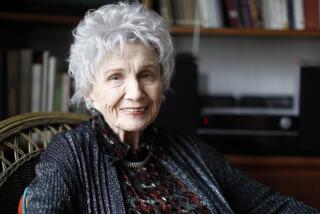An Entire Life History in a Page : ALICE MUNRO: Selected Stories.<i> By Alice Munro (Alfred A. Knopf: $30, 545 pp.)</i>
- Share via
The heroine of “Differently,” my favorite Alice Munro story, once tried to write fiction. She took a class. But the teacher criticized her work as insufficiently focused: He said she had “too many things going on at the same time; also too many people.” He told her to think harder about “the important thing” and to write about that thing. And so our heroine, Georgia, wrote a narrow little tale about her grandfather and chickens. She didn’t like it, but her teacher liked it very much. Georgia gave up trying to write and moved in with her teacher.
These events, which transpire in the first three paragraphs of “Differently,” offer ironic comment on the 20 pages that follow: a story with enough people and “things going on” to fill an entire novel. There is Georgia’s visit to a friend from her past; there are remembrances of former husbands and lovers and seductions and betrayals; there is a mournful sense of futility and bafflement; there is a small, cherished moment of peace and clarity. There is no one “important thing,” Munro is telling us, but a whole series of things: Stories, like life, take on meaning through a process of accumulation.
This month, Knopf publishes Munro’s “Selected Stories”--28 pieces, including “Differently,” culled from seven previous collections. A Canadian writer, Munro has been publishing stories for almost 30 years; they have earned her massive acclaim. This new collection offers both a fine testament to the stories that have made Munro’s reputation--”Something I’ve Been Meaning to Tell You,” “The Progress of Love,” “Miles City, Montana,” “Friend of My Youth”--and a delightful opportunity for the reader to journey at length in Munro’s fictional territory.
For the most part, the stories gathered here take place in the small towns and farms around Lake Huron, Ontario, in the present times of their publication or in the earlier times of childhoods passed in the first half of this century. While the collection contains small pockets of surreal mystery (in “Carried Away,” “A Wilderness Station,” “The Albanian Virgin”) Munro is above all else a realist. She seeks to evoke the mysteries of real life and she succeeds brilliantly.
The important people in Munro’s fiction are women: women in their roles as lovers, women in their roles as daughters. If these women are little concerned with national politics or the world at large, they take a great deal of interest in their own pocketbooks and even more in their own romances. These are the things, Munro suggests, that give shape to ordinary lives; these are the things that really matter.
The narrative voice is frequently the most commanding presence in a Munro story. At times, especially in Munro’s many first-person stories, her narrative voices can sound fairly similar. Rather than constituting a fault, however, this similarity adds weight to Munro’s total achievement. It melds individual stories into a cohesive body of work; it distinguishes Munro’s writing from other writing.
Despite current notions that a writer should seek to “show,” rather than to narrate events, Munro’s narrators actually narrate. Intelligent, detached, often funny, always serious, they move boldly from past to present, place to place. Inclined upon occasion to sweep through an entire life history in a page, or even a paragraph, they pause upon other occasions to ponder the minutest details of a particular thought or realization. Thus Isabel, in “White Dump,” sits alone for a time on her husband’s 40th birthday, which will also be the eve of her first love affair, grasping that her marriage has been a succession of “hurdles got through,” of demands for emotions that she does not feel. It is a devastating moment: “not much to her credit to go through her life thinking, ‘Well, good, now that’s over, that’s over.’ ”
A typical Munro woman has been married for many years and also divorced for many years. Love has both exceeded and fallen short of her expectations. In “Miles City, Montana,” a child begins to drown, out of sight of her parents. As if by magic--an awesome, invisible bond--mother and father are led to save her. Later, they divorce.
In “Dulse,” a woman named Lydia spends a night alone on an island, in a guest-house. She is depressed to the point of numbness over the end of her relationship with a man she had adored to “the abdication of all pride and sense.” And yet, in the morning, she discovers that a quiet, simple man, to whom she had barely spoken the night before, has left a gift for her on his way off the island: a bag of dulse, a kind of seaweed. Of course, Lydia is still depressed. “Yet look,” Munro writes, in the story’s final line, “how this present slyly warmed her, from a distance.”
The prospect of love makes Munro’s women--like Louisa, heroine of “Carried Away”--feel “a hush, a flutter along the nerves, a bowing down of sense, a flagrant prostration.” With such forces at work in the world, these women, whether married or not, cannot resist romantic affairs. Their affairs start casually, with a man who happens to present himself; they pass through a brief phase of delight, and a longer phase of desperation; they end badly. Munro excels at depicting the phase of dissolution. In “Differently,” this phase begins just after Georgia and her lover Miles say the words “I love you” for the first time. “Next time a rift opened. At first they simply tested it, to see if it was there. It was almost like a new diversion to them. But it widened, it widened.”
As rifts widen, in “Differently” and in other stories, lovers vie to top each other in cruelty. They thrill in inflicting pain; they crave mutual destruction; they take perverse delight in sinking to new depths. Four of the stories in this collection, companion pieces, are an extended comment on this depraved sort of pleasure: “Royal Beatings,” “Wild Swans,” “The Beggar Maid” and “Simon’s Luck.”
Munro’s women and girls, unlike her men, are intensely curious about life. They are especially curious about their parents. In the first story of this collection, “Walker Brothers Cowboy,” a girl named Nora accompanies her father on a visit to one of his old girlfriends and is surprised to learn that her father drinks whiskey: “One of the things my mother has told me in our talks together is that my father never drinks whiskey. But I see he does.” Parents, Munro knows, are full of such surprises and secrets. The narrator of “The Moons of Jupiter” realizes this. So does the narrator of “The Ottawa Valley,” who tells her story as part of an effort to “find out more, remember more,” about her mother. “It is to reach her that this whole journey had been undertaken. With what purpose? To mark her off, to describe, to illumine, to celebrate, to get rid, of her.”
This is what all art seeks: a coming to terms. What Munro achieves, and what she offers to her readers, is a vantage from which such a consummation feels possible.
More to Read
Sign up for our Book Club newsletter
Get the latest news, events and more from the Los Angeles Times Book Club, and help us get L.A. reading and talking.
You may occasionally receive promotional content from the Los Angeles Times.








